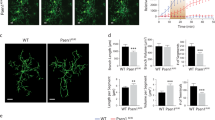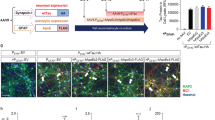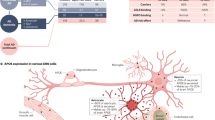Abstract
We have previously shown that apolipoprotein E (Apoe) promotes the formation of amyloid in brain and that astrocyte-specific expression of APOE markedly affects the deposition of amyloid-β peptides (Aβ) in a mouse model of Alzheimer disease. Given the capacity of astrocytes to degrade Aβ, we investigated the potential role of Apoe in this astrocyte-mediated degradation. In contrast to cultured adult wild-type mouse astrocytes, adult Apoe−/− astrocytes do not degrade Aβ present in Aβ plaque–bearing brain sections in vitro. Coincubation with antibodies to either Apoe or Aβ, or with RAP, an antagonist of the low-density lipoprotein receptor family, effectively blocks Aβ degradation by astrocytes. Phase-contrast and confocal microscopy show that Apoe−/− astrocytes do not respond to or internalize Aβ deposits to the same extent as do wild-type astrocytes. Thus, Apoe seems to be important in the degradation and clearance of deposited Aβ species by astrocytes, a process that may be impaired in Alzheimer disease.
This is a preview of subscription content, access via your institution
Access options
Subscribe to this journal
Receive 12 print issues and online access
$209.00 per year
only $17.42 per issue
Buy this article
- Purchase on Springer Link
- Instant access to full article PDF
Prices may be subject to local taxes which are calculated during checkout






Similar content being viewed by others
References
Saunders, A.M. et al. Association of apolipoprotein E allele ε4 with late-onset familial and sporadic Alzheimer's disease. Neurology 43, 1467–1472 (1993).
Rebeck, G.W., Reiter, J.S., Strickland, D.K. & Hyman, B.T. Apolipoprotein E in sporadic Alzheimer's disease: allelic variation and receptor interactions. Neuron 11, 575–580 (1993).
Strittmatter, W.J. et al. Binding of human apolipoprotein E to synthetic amyloid β peptide: isoform-specific effects and implications for late-onset alzheimer disease. Proc. Natl. Acad. Sci. USA 90, 8098–8102 (1993).
Schmechel, D.E. et al. Increased amyloid β-peptide deposition in cerebral cortex as a consequence of apolipoprotein E genotype in late-onset alzheimer disease. Proc. Natl. Acad. Sci. USA 90, 9649–9653 (1993).
Bales, K.R. et al. Lack of apolipoprotein E dramatically reduces amyloid β-peptide deposition. Nat. Genet. 17, 263–264 (1997).
Bales, K.R. et al. Apolipoprotein E is essential for amyloid deposition in the APPV717F transgenic mouse model of Alzheimer's disease. Proc. Natl. Acad. Sci. USA 96, 15233–15238 (1999).
Holtzman, D.M. et al. Expression of human apolipoprotein E reduces amyloid-β deposition in a mouse model of Alzheimer's disease. J. Clin. Invest. 103, R15–R21 (1999).
Fagan, A.M. et al. Human and murine apoE markedly influence Aβ metabolism before and after plaque formation in a mouse model of Alzheimer's disease. Neurobiol. Dis. 9, 305–318 (2002).
Wyss-Coray, T. et al. TGF-β1 promotes microglial amyloid-β clearance and reduces plaque burden in transgenic mice. Nat. Med. 7, 612–618 (2001).
Bard, F. et al. Peripherally administered antibodies against amyloid β-peptide enter the central nervous system and reduce pathology in a mouse model of Alzheimer's disease. Nat. Med. 6, 916–919 (2000).
Bacskai, B.J. et al. Non-Fc-mediated mechanisms are involved in clearance of amyloid-β in vivo by immunotherapy. J. Neurosci. 22, 7873–7878 (2002).
Frackowiak, J. et al. Ultrastructure of the microglia that phagocytose amyloid and the microglia that produce β-amyloid fibrils. Acta. Neuropathol. (Berl.) 84, 225–233 (1992).
Rogers, J., Strohmeyer, R., Kovelowski, C.J. & Li, R. Microglia and inflammatory mechanisms in the clearance of amyloid β peptide. Glia 40, 260–269 (2002).
Wisniewski, H.M., Wegiel, J., Wang, K.C., Kujawa, M. & Lach, B. Ultrastructural studies of the cells forming amyloid fibers in classical plaques. Can. J. Neurol. Sci. 16, 535–542 (1989).
Wisniewski, H.M., Wegiel, J. & Kotula, L. Some neuropathological aspects of Alzheimer's disease and its relevance to other disciplines. Neuropathol. Appl. Neurobiol. 22, 3–11 (1996).
Wegiel, J. et al. The role of microglial cells and astrocytes in fibrillar plaque evolution in transgenic APP(SW) mice. Neurobiol. Aging 22, 49–61 (2001).
Meda, L. et al. Activation of microglial cells by β-amyloid protein and interferon-γ. Nature 374, 647–650 (1995).
Giulian, D. et al. Specific domains of β-amyloid from Alzheimer plaque elicit neuron killing in human microglia. J. Neurosci. 16, 6021–6037 (1996).
Qin, L. et al. Microglia enhance β-amyloid peptide–induced toxicity in cortical and mesencephalic neurons by producing reactive oxygen species. J. Neurochem. 83, 973–983 (2002).
Shao, Y. & McCarthy, K.D. Plasticity of astrocytes. Glia 11, 147–155 (1994).
Montgomery, D.L. Astrocytes: form, functions, and roles in disease. Vet. Pathol. 31, 145–167 (1994).
Hatten, M.E., Liem, R.R.M., Shelanset, M.L. & Mason, C.A. Astroglia in CNS injury. Glia 4, 233–243 (1991).
Al-Ali, S.Y. & Al-Hussain, S.M. An ultrastructural study of the phagocytic activity of astrocytes in adult rat brain. J. Anat. 188, 257–262 (1996).
Guillaume, D., Bertrand, P., Dea, D. & Poirier, J. Apolipoprotein E and low-density lipoprotein binding and internalization in primary cultures of rat astrocytes: isoform specific alterations. J. Neurochem. 66, 2410–2418 (1996).
Funato, H. et al. Astrocytes containing amyloid β-protein (Aβ)-positive granules are associated with Aβ40-positive diffuse plaques in the aged human brain. Am. J. Pathol. 152, 983–992 (1998).
Matsunaga, W., Shirokawa, T. & Isobe, K. Specific uptake of Aβ1-40 in rat brain occurs in astrocyte, but not in microglia. Neurosci. Lett. 342, 129–131 (2003).
Wegiel, J., Wang, K.C., Tarnawsk, M. & Lach, B. Microglia cells are the driving force in fibrillar plaque formation, whereas astrocytes are a leading factor in plague degradation. Acta. Neuropathol. (Berl). 100, 356–364 (2000).
Wyss-Coray, T. et al. Adult mouse astrocytes degrade amyloid-β in vitro and in situ. Nat Med. 9, 453–457 (2003).
Nitta, T., Yagita, H., Sato, K. & Okumura, K. Expression of Fc γ receptors on astroglial cell lines and their role in the central nervous system. Neurosurgery 31, 83–87 (1992).
Warshawsky, I., Bu, G. & Schwartz, A.L. 39-kD protein inhibits tissue-type plasminogen activator clearance in vivo. J. Clin. Invest. 92, 937–944 (1993).
Gylys, K.H., Fein, J.A., Tan, A.M. & Cole, G.M. Apolipoprotein E enhances uptake of soluble but not aggregated amyloid-β protein into synaptic terminals. J. Neurochem. 84, 1442–1451 (2003).
Urmoneit, B. et al. Cerebrovascular smooth muscle cells internalize Alzheimer amyloid β protein via a lipoprotein pathway: implications for cerebral amyloid angiopathy. Lab. Invest. 77, 157–166 (1997).
Thal, D.R. et al. Amyloid β-protein (Aβ)-containing astrocytes are located preferentially near N-terminal-truncated Aβ deposits in the human entorhinal cortex. Acta. Neuropathol. 100, 608–617 (2000).
Yamaguchi, H., Sugihara, S., Ogawa, A., Saido, T.C. & Ihara, Y. Diffuse plaques associated with astroglial amyloid β protein, possibly showing a disappearing stage of senile plaques. Acta. Neuropathol. 95, 217–222 (1998).
De Groot, C.J. et al. Establishment of human adult astrocyte cultures derived from postmortem multiple sclerosis and control brain and spinal cord regions: immunophenotypical and functional characterization. J. Neurosci. Res. 49, 342–354 (1997).
Saura, J., Petegnief, V., Wu, X., Liang, Y. & Paul, S.M. Microglial apolipoprotein E and astroglial apolipoprotein J expression in vitro: opposite effects of lipopolysaccharide. J. Neurochem. 85, 1455–1467 (2003).
Marr, R.A. et al. Neprilysin gene transfer reduces human amyloid pathology in transgenic mice. J. Neurosci. 23, 1992–1996 (2003).
Manders, E.E.M, Verbeek, F.J. & Aten, J.A. Measurement of co-localisation of objects in dual-colour images. J. Microsc. 169, 375–382 (1993).
Acknowledgements
We thank R. DeMattos for comments. M.K. was supported, in part, by the Saastamoinen Foundation and the Finnish Cultural Foundation of Northern Savo, Kuopio, Finland.
Author information
Authors and Affiliations
Corresponding author
Ethics declarations
Competing interests
S.L., X.W., M.E., D.K., J.H., R.H., F.L., S.M., K.R.B. and S.M.P. are employees of Eli Lilly and Company, and several of them own stock in the company.
Supplementary information
Supplementary Figure 2
Preincubation of tissue sections or astrocytes with anti-Apoe antibosy fails to block astrocyte-mediated Aβ degradation. (PDF 158 kb)
Supplementary Figure 3
Adult WT astrocytes aggregate and form extended processes when exposed to PDAPP mouse brain sections. (PDF 450 kb)
Rights and permissions
About this article
Cite this article
Koistinaho, M., Lin, S., Wu, X. et al. Apolipoprotein E promotes astrocyte colocalization and degradation of deposited amyloid-β peptides. Nat Med 10, 719–726 (2004). https://doi.org/10.1038/nm1058
Received:
Accepted:
Published:
Issue Date:
DOI: https://doi.org/10.1038/nm1058
This article is cited by
-
APOE ε4 gene dose effect on imaging and blood biomarkers of neuroinflammation and beta-amyloid in cognitively unimpaired elderly
Alzheimer's Research & Therapy (2023)
-
Cellular prion protein offers neuroprotection in astrocytes submitted to amyloid β oligomer toxicity
Molecular and Cellular Biochemistry (2023)
-
APOE genotype and biological sex regulate astroglial interactions with amyloid plaques in Alzheimer’s disease mice
Journal of Neuroinflammation (2022)
-
Enhanced delivery of a low dose of aducanumab via FUS in 5×FAD mice, an AD model
Translational Neurodegeneration (2022)
-
Astrocytic and microglial cells as the modulators of neuroinflammation in Alzheimer’s disease
Journal of Neuroinflammation (2022)



